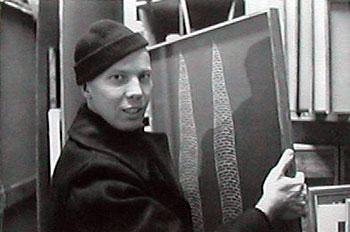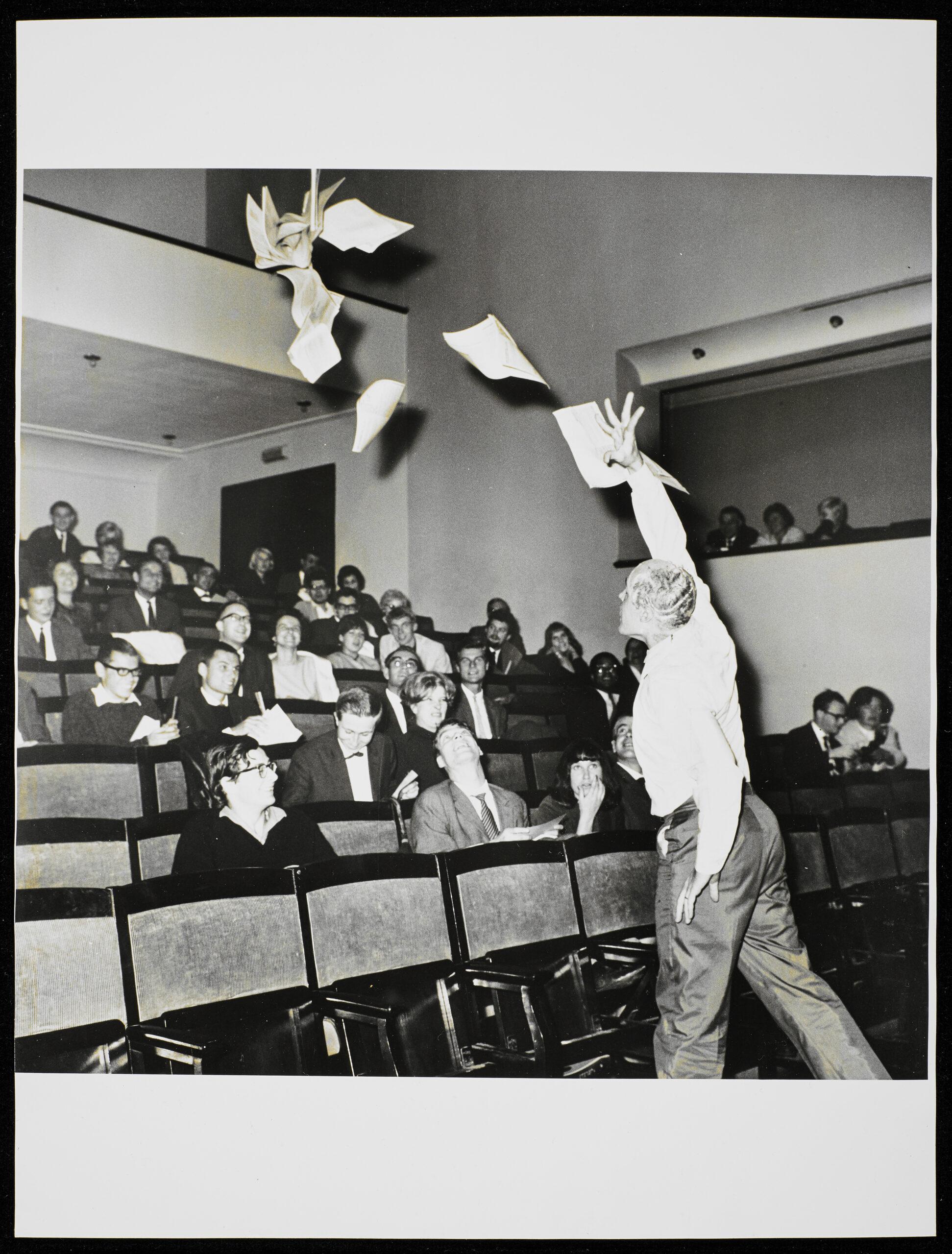
Raymond Edward Johnson (1927–1995), collagist and correspondence artist. Photograph by William S. Wilson, circa 1968.
Ray Johnson (1927–1995) arrived at Black Mountain College from Detroit at age 17, for the 1945 Summer Institute, as WWII was coming to a close. The formidable Josef Albers was at the helm, and by the time Johnson left the college more than three years later, he’d studied alongside fellow students Hazel Larsen Archer, Ruth Asawa and Kenneth Noland while both Josef and Anni Albers, Ilya Bolotowsky, John Cage, Merce Cunningham, Lyonel Feininger, Buckminster Fuller, Walter Gropius, Willem and Elaine de Kooning, Richard Lippold, Alvin Lustig, Robert Motherwell, M. C. Richards, and many others taught at or visited BMC during this robust era of its history.
In 1949, Ray moved with sculptor Richard Lippold to New York, where he continued several friendships—and embarked upon new ones—with others who had come to the city from Black Mountain College. Originally a painter exhibiting with the American Abstract Artists group, Ray had turned to collage by 1955, when BMC alum Andy Oates (who exhibited several others who’d also attended the college) gave Ray his first real solo show at his Boylston Street Print Gallery in Cambridge, Massachusetts.
No longer making paintings, Ray founded the New York Correspondence School (named in 1962 by an NYCS “member”) as a way of randomly distributing his small collages and printed ephemera toan ever-widening circle of accomplices, all of them, like Ray, mail-ing to and for each other envelopes stuffed with their art, clippings, junk, almost anything the postal service would transport. Missives and flyers with the phrases “please add to and return”, “please add and send to…”, and even “please do not send to…” circulated; often the mailings contained references that would only be understood by their intended addressees. Dick Higgins was a recipient of Ray’s own mailings, and the contents of some of those mailings became The Paper Snake (1965).
A decade after the 1955 show in Cambridge, Ray had a series of well-received solo exhibitions over a six-year period from 1965 to 1971, at the Willard Gallery in New York (via Richard Lippold) and at Richard Feigen Gallery’s New York and Chicago locations. On April Fool’s Day of 1968, the NYCS held the first of its many “meetings,” gatherings called by Ray at which something might, but didn’t have to, happen. Weeks later Ray, startled by the shooting of his friend Andy Warhol, moved from New York, eventually settling in the small Long Island town where Lippold and family then lived.
1978 was the last year in which Ray would exhibit in a solo show at a commercial gallery. His NYCS meetings and public performances became less frequent and ceased altogether in 1988. Only after his suicide by drowning in January of his 68th year could Ray Johnson’s work once more be widely appreciated. Ray’s collages and mail art are now regularly shown at museums throughout the world, and an award-winning feature-length documentary, How to Draw a Bunny, was released in 2002.
Dick Higgins in his “Danger Music #2,” performance by Higgins and Alison Knowles at Fluxus Internationale Festspiele Neuster Musik, Weisbaden, Germany, 1962. “Danger Music #2: Hat. Rags. Paper. Heave. Shave. May 1961”. Photo by Hartmut Rekort (often misattributed to George Maciunas). Courtesy Hartmut Rekort Fotoarchiv, Hamburg
Dick Higgins (1938–1998) was born in Cambridge, England, and raised in the U.S. Having moved to New York, Higgins enrolled in the hugely influential music composition class given by John Cage at The New School in New York in 1958. Two years later he married fellow artist Alison Knowles (who he probably met via Ray Johnson); Knowles and Higgins had twin daughters and later divorced, reunited, and remarried. Primarily a poet and performer, Higgins was a proponent of what he termed “intermedia,” or the merging of two or more art forms. Ray Johnson’s embraces of text, drawing, collage, and the act of mailing them appealed to Dick, and when he founded Something Else Press in 1963, The Paper Snake was its second title, immediately following a volume of his own writings. Having produced books which are now recognized as classics, the press went bankrupt in 1974, though Higgins continued to perform and to create, and later to self-publish, his written work until his sudden death of a heart attack.


